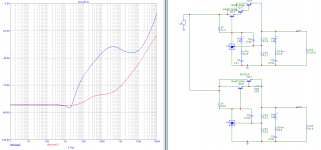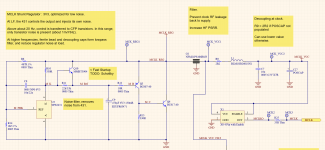I`m sorry. No schematic program on this laptop. I will have to explain in words.
The 10uF seems right. I use it myself in my TL431 regulators. It is recommended in the TL431 datasheet if the TL431 has more than a minimum of capacitive loading. Figure 16 of the TI datasheet.
Darlington transistor - Wikipedia describes the ordinary (two transistor) NPN Darlington coupling. Your add another NPN transistor to the upper NPN transistor and you have the triple NPN Darlington coupling. That is what is used in your circuit.
I'm glad I got it right, 🙂, but still the same question,...how to make it ultra-low noise reg?
🙂
How to make "it" ultra-low noise implies that you maintain the circuit substantially as it is. With the circuit you have, the inherent level of noise is decided by the components used and is quite low but not ultra-low. There is no ultra-low noise trick you just add to an existing circuit. Noise cancelling circuits is the only option but do not provide real "ultra". Look for Elvee designs as some of the best.
If you really want to design an ultra-low noise regulator circuit, you need to use ultra-low noise components, in particular for the band-gap reference. Making real ultra-low noise regulators is an art, not trivial design. Semiconductor companies have spend millions on developing such circuits. Use one of the best ICs from their range of voltage regulators.
Ultra-low noise you need in particular for scientific circuits and measurement. Perhaps for a high performance DAC. Be careful not to exaggerate your needs for ultra-low noise. Many persons design for ultra-low noise for applications where they will not notice the difference.
If you really want to design an ultra-low noise regulator circuit, you need to use ultra-low noise components, in particular for the band-gap reference. Making real ultra-low noise regulators is an art, not trivial design. Semiconductor companies have spend millions on developing such circuits. Use one of the best ICs from their range of voltage regulators.
Ultra-low noise you need in particular for scientific circuits and measurement. Perhaps for a high performance DAC. Be careful not to exaggerate your needs for ultra-low noise. Many persons design for ultra-low noise for applications where they will not notice the difference.
Last edited:
I did measure the noise of the supply under load and it is in 1mV area,
I don't know how low that is but it's quite low, correct me if I'm wrong.
many thanx for your help.
I don't know how low that is but it's quite low, correct me if I'm wrong.
many thanx for your help.
My own experience with TL431 is noise in the order of 50-100uVrms. Not bad at all but not a couple of uV either.
hi,
did you look at the last schematics???
*18 post
OK, that should work.
Still makes no sense to use a triple darlington though...
Note the whole concept of "yuuultra low noise regulators" for audio is a gimmick. First, it ignores PSRR. If the thing is yultra low noise only when powered from another yuuultra low noise regulator, because it has low PSRR, then duh. Next, it ignores output impedance: if the load draws a variable current, then the output voltage will never be stable to 1µV anyway, so optimizing the noise kinda misses the point. And finally, opamps have huge PSRR at the frequencies of interest anyway.
It's okay for loads that draw constant current though, like clocks or DAC reference voltage, for example.
I see +5V output on the schematic. If you are using this to power a raspberry pi, a squeezebox, or something like that, relax, the switching converter on the input of that is going to make a ton of noise anyway, so it doesn't really matter what the regulator does.
Last edited:
noted!,..thank you!My own experience with TL431 is noise in the order of 50-100uVrms. Not bad at all but not a couple of uV either.
planning to use it for a clock supply,...thank you 🙂OK, that should work.
Still makes no sense to use a triple darlington though...
Note the whole concept of "yuuultra low noise regulators" for audio is a gimmick. First, it ignores PSRR. If the thing is yultra low noise only when powered from another yuuultra low noise regulator, because it has low PSRR, then duh. Next, it ignores output impedance: if the load draws a variable current, then the output voltage will never be stable to 1µV anyway, so optimizing the noise kinda misses the point. And finally, opamps have huge PSRR at the frequencies of interest anyway.
It's okay for loads that draw constant current though, like clocks or DAC reference voltage, for example.
I see +5V output on the schematic. If you are using this to power a raspberry pi, a squeezebox, or something like that, relax, the switching converter on the input of that is going to make a ton of noise anyway, so it doesn't really matter what the regulator does.
MCKL reg is a voltage input?,..I would assume.
looks interesting, have you tried it yourself?
seems to be very low noise?
looks interesting, have you tried it yourself?
seems to be very low noise?
The top port "MCLK_REG" connects to a current source on another schematic sheet, since it's a shunt reg.
I've put it in my DAC, it works well.
The low noise is due to the fact the TL431 only controls the output at very low frequency, due to the large capacitor. So it sets the DC point, compensates for temperature and Vbe, and adds its own 1/f low frequency noise into the output. But above a few Hz, the output is controlled by the transistors only, which have noise of about 1nV/rtHz. So the highish TL431 noise floor is filtered out.
I've put it in my DAC, it works well.
The low noise is due to the fact the TL431 only controls the output at very low frequency, due to the large capacitor. So it sets the DC point, compensates for temperature and Vbe, and adds its own 1/f low frequency noise into the output. But above a few Hz, the output is controlled by the transistors only, which have noise of about 1nV/rtHz. So the highish TL431 noise floor is filtered out.
The top port "MCLK_REG" connects to a current source on another schematic sheet, since it's a shunt reg.....
would you mid posting the current source schematics sheet?
that would help a lot.
🙂
would you mid posting the current source schematics sheet?
that would help a lot.
🙂
I believe what you say but it is not a circuit that costs 1 $ 🙂
hahahah, that's what I was thinking 🙂
but still cheap enough!
First, it ignores PSRR. If the thing is yultra low noise only when powered from another yuuultra low noise regulator, because it has low PSRR, then duh. Next, it ignores output impedance: if the load draws a variable current, then the output voltage will never be stable to 1µV anyway, so optimizing the noise kinda misses the point. And finally, opamps have huge PSRR at the frequencies of interest anyway.
So what would be a benchmark for you ?
Something like this ?
RMS Noise: 0.8μVRMS (10Hz to 100kHz)
Spot Noise: 2nV/√Hz at 10kHz, 30nV/√Hz at 10Hz
PSRR: 115dB at 100Hz, 76dB at 1MHz
Load regulation: 0.1mV for 1mA to 500mA
Load transient: <30mV over 20µs for jump from 500mA to 10mA
Patrick
So what would be a benchmark for you ?
Something like this ?
RMS Noise: 0.8μVRMS (10Hz to 100kHz)
Spot Noise: 2nV/√Hz at 10kHz, 30nV/√Hz at 10Hz
PSRR: 115dB at 100Hz, 76dB at 1MHz
Load regulation: 0.1mV for 1mA to 500mA
Load transient: <30mV over 20µs for jump from 500mA to 10mA
That's good, what design is it?
The original chinese reg can be improved: making the triple darlington into a double and biasing its driving transistor with some current (via a resistor) ; also the 10µF cap across the TL431 doesn't do anything so it goes away. This won't change the TL431 noise but it gets better PSRR.

- Home
- Amplifiers
- Power Supplies
- ultra low noise psu from China

